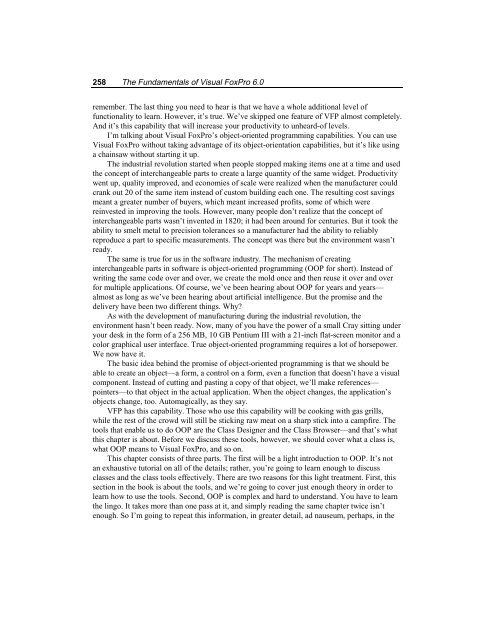Chapter 10 Using VFP's Object- Oriented Tools - dFPUG-Portal
Chapter 10 Using VFP's Object- Oriented Tools - dFPUG-Portal
Chapter 10 Using VFP's Object- Oriented Tools - dFPUG-Portal
Create successful ePaper yourself
Turn your PDF publications into a flip-book with our unique Google optimized e-Paper software.
258 The Fundamentals of Visual FoxPro 6.0<br />
remember. The last thing you need to hear is that we have a whole additional level of<br />
functionality to learn. However, it’s true. We’ve skipped one feature of VFP almost completely.<br />
And it’s this capability that will increase your productivity to unheard-of levels.<br />
I’m talking about Visual FoxPro’s object-oriented programming capabilities. You can use<br />
Visual FoxPro without taking advantage of its object-orientation capabilities, but it’s like using<br />
a chainsaw without starting it up.<br />
The industrial revolution started when people stopped making items one at a time and used<br />
the concept of interchangeable parts to create a large quantity of the same widget. Productivity<br />
went up, quality improved, and economies of scale were realized when the manufacturer could<br />
crank out 20 of the same item instead of custom building each one. The resulting cost savings<br />
meant a greater number of buyers, which meant increased profits, some of which were<br />
reinvested in improving the tools. However, many people don’t realize that the concept of<br />
interchangeable parts wasn’t invented in 1820; it had been around for centuries. But it took the<br />
ability to smelt metal to precision tolerances so a manufacturer had the ability to reliably<br />
reproduce a part to specific measurements. The concept was there but the environment wasn’t<br />
ready.<br />
The same is true for us in the software industry. The mechanism of creating<br />
interchangeable parts in software is object-oriented programming (OOP for short). Instead of<br />
writing the same code over and over, we create the mold once and then reuse it over and over<br />
for multiple applications. Of course, we’ve been hearing about OOP for years and years—<br />
almost as long as we’ve been hearing about artificial intelligence. But the promise and the<br />
delivery have been two different things. Why?<br />
As with the development of manufacturing during the industrial revolution, the<br />
environment hasn’t been ready. Now, many of you have the power of a small Cray sitting under<br />
your desk in the form of a 256 MB, <strong>10</strong> GB Pentium III with a 21-inch flat-screen monitor and a<br />
color graphical user interface. True object-oriented programming requires a lot of horsepower.<br />
We now have it.<br />
The basic idea behind the promise of object-oriented programming is that we should be<br />
able to create an object—a form, a control on a form, even a function that doesn’t have a visual<br />
component. Instead of cutting and pasting a copy of that object, we’ll make references—<br />
pointers—to that object in the actual application. When the object changes, the application’s<br />
objects change, too. Automagically, as they say.<br />
VFP has this capability. Those who use this capability will be cooking with gas grills,<br />
while the rest of the crowd will still be sticking raw meat on a sharp stick into a campfire. The<br />
tools that enable us to do OOP are the Class Designer and the Class Browser—and that’s what<br />
this chapter is about. Before we discuss these tools, however, we should cover what a class is,<br />
what OOP means to Visual FoxPro, and so on.<br />
This chapter consists of three parts. The first will be a light introduction to OOP. It’s not<br />
an exhaustive tutorial on all of the details; rather, you’re going to learn enough to discuss<br />
classes and the class tools effectively. There are two reasons for this light treatment. First, this<br />
section in the book is about the tools, and we’re going to cover just enough theory in order to<br />
learn how to use the tools. Second, OOP is complex and hard to understand. You have to learn<br />
the lingo. It takes more than one pass at it, and simply reading the same chapter twice isn’t<br />
enough. So I’m going to repeat this information, in greater detail, ad nauseum, perhaps, in the

















